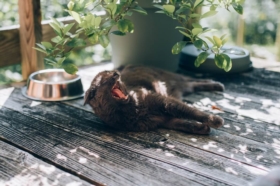




The facade and the roof are what we notice first when approaching a house. This is the outside of the building that most often includes the main entrance. Fundamental initial element, it is the object of a particular attention from the conception to the realization. It must therefore be up to your expectations.
A customizable façade (almost)
Renovating a facade is often a necessity decision when the color begins to fade or when moisture appears. The look of a facade is important. The choice of material and shade should not be left to chance . Many coatings are now available, next to the eternal bricks, to satisfy your desires for originality.Caution, if you plan a facelift, contact your town. These works are regulated, especially for classified sites.
Wood has the wind in its sails
To completely cover your house with wood is the big trend of recent years. Many homeowners make this choice for aesthetic reasons. The wooden house no longer looks like a cottage, it displays a more contemporary style with clean forms allowing great freedom in the choice of shapes and volumes. The wood has also become democratized. Indeed, the gap with the brick has almost resorbed.Donnant a rustic character sometimes modern, the wood still requires regular maintenance on your part . To protect your wooden facade against the onslaught of weather or bad weather and keep its aesthetic characteristics, you must use fungicides (against fungi), insecticides or water-repellent products (against moisture) .Unfortunately, even this protection can not 100% protection of wood from stains or loss of radiance due to UV. Covering exterior wood with protective paint is the best way to combat these various problems.
Bamboo canes to fight against heat
A rather original but useful choice to protect your home from the heat of the sun. Bamboo stems were previously used to create palisades, fences or screening panels. Recently, they also cover facades by making them more graphic and airy . If you want a second aesthetic skin for your home, bamboo canes will satisfy you. In front of your windows and bay windows, they will also play the role of louvers. Main advantage: bamboo canes are particularly robust and withstand high pressures . For their installation, make sure to call in a carpenter or a landscaper and favor the sunny facades. In the shade, bamboo can produce starch that causes mold.
A plant facade, architectural element
A plant facade is no longer limited to the planting of a climbing ivy but is now based on neat structures. It is not only used to hide the imperfections of your facades, it is an integral part of the architecture. The walls of vegetation have conquered the owners of individual houses, but also those of public buildings and shops. The 'green wall' allows you to transform your facade into a real garden. A wise choice, especially in large cities that are sorely lacking green space. It offers you many advantages: it introduces greenery on your bare walls, it positively influences the urban climate and it offers good thermal and acoustic insulation.
When choosing your plants, remember that most of them grow horizontally and do not survive on a vertical structure. Direct vegetation includes self-climbing plants such as ivy and vines, while indirect vegetation includes twining, twining, or adventitious root plants requiring climbing support. Of these, honeysuckle, wisteria and clematis.
The 'green wall' also protects your facade against the weather, it acts as a shield. Properly oriented, your vertical garden can last for years. Provided, however, maintain.The plant face has some disadvantages, as its price. The wall of vegetation is more expensive than other coverings (brick, wood, ...). Some plants may also cause joint damage and seep into cracks or holes in your walls.
The roof, the protective element
The renovation of the roofs must be done every 45 years. The opportunity to look at the different possibilities available to you in terms of materials or inclination. Unless you live in a region with typical and uniform roofs ( slate or tile), you have a free field in terms of your roof.
A flat or sloping roof?
You want to build and have a clear idea of the type of your house? Here are some tips to help you choose the roof that will work best. The sloped roof remains the norm and offers many benefits. If you feel the soul of a handyman, you can try to make it yourself. It also gives you extra space, for a games room, a dressing room or a second bathroom, and promotes the evacuation of water.
More and more modern enthusiasts are opting for a flat roof. This type of roof, initially intended for non-residential buildings, is more and more popular for individual homes. Especially for modern villas. The problem of these roofs is that their integration where sloping roofs prevail is often not allowed and, unlike sloped roofs, flat roofs make it difficult to evacuate water.
Tiles and slates, a safe bet
Most roofs are made with terracotta tiles , available in many formats, shapes and colors. Concrete tiles offer a better quality / price ratio and are backed by a 30-year guarantee. Natural slates are still very popular, while fiber-cement slates are larger and cheaper. more and more popular.
The return of thatch
Thatch has long been the most used material in our regions for roofing. He then left room for tiles and slates that we know well. Its use was then limited to the annexes and stables. A few years ago, thatch has made a big comeback on the roofs of residential houses and villas. However, we must put the price. Indeed, a thatched roof is more expensive than a traditional roof because its installation requires more time and manpower. Despite its cost, stubble always attracts more. Aesthetics is the main reason advanced by the owners to justify their choice. But thatch is also one of the best natural insulators and requires little maintenance. The life of this type of roof depends on the constructive system but also the sun exposure, the type of thatch and the angle of inclination of the roof. The traditional system, designed for an open roof, has a lifespan of more than 40 years; while the so-called 'screw-on roof system' applies to closed constructions and lasts about 30 years.
Green roofs, a corner of paradise
You live in town and you miss the greenery? The green roof is for you. A true refuge for some, this increasingly popular space offers many advantages: it increases the life of your roof, it promotes thermal / acoustic insulation and it is a rainwater regulator stock on the roof. The choice of plants is unlimited, it depends only on your preferences and your budget. The more weight the roof can support, the more substrate you can put on it. A green roof is actually a hanging garden. There are two types : the intensive green roof and the extensive green roof.
- The intensive green roof is landscaped. There are trees, trails, ponds, swimming pools, terraces, grass, ... It requires maintenance, money and can weigh up to 1500kg per sqm. So make sure your roof supports such a load.
- The extensive green roof is easier to implement. It is covered with plants but is not equipped for intensive use. We can not walk there. Its weight can reach up to 200kg per m².
An intermediate solution exists: the simplified intensive green roof. Heavier than the extensive and less abundant than the intensive, it is suitable for roofs whose inclination is less than 15 °. The hanging garden not only improves the landscape (see more greenery is relaxing and de-stressing) but also the ambient climate (more greenery produces more oxygen). The trend towards revegetation of roofs is part of a desire for sustainable development and meets the requirements of buildings with high environmental quality.
Only downside: the risk of leaks. To avoid having to dismount your little piece of heaven to find the source of the leak, call on a professional who will ensure the watertightness of your roof.